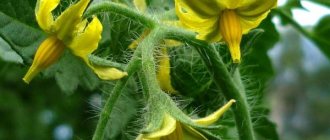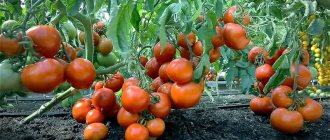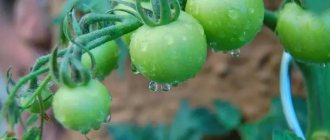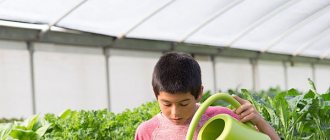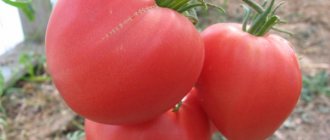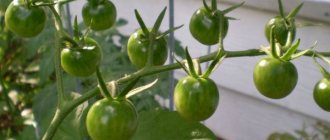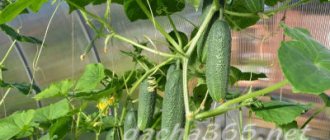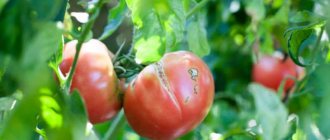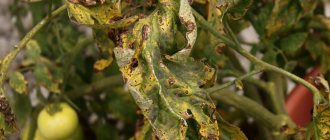After the publication of my article about potatoes, the question was raised in the comments about the taste of home grown tomatoes, grown in greenhouses on a personal plot, and industrial tomatoes. Industrial cultivation of vegetables, including tomatoes, takes place in open ground in the southern regions of our country, and since most of Russia is located in a zone of risky agriculture, to obtain a harvest one cannot do without structures to protect the soil from adverse weather conditions - greenhouses. In this article we will talk about the technologies that are used in industrial crop production and what steps need to be taken to grow standard tomatoes.
Source
Growing tomatoes business
Industrial cultivation of tomatoes in open ground.
Tomato business, photos, videos. Tomato is a high-yielding vegetable crop; it is often grown on an industrial scale in greenhouses, this is due to the fact that this can create the most favorable conditions for obtaining maximum yields. But in this article we will talk about the industrial cultivation of tomatoes in open ground without the use of covering materials.
When growing tomatoes in open ground, the yield is very dependent on weather conditions; even with the use of irrigation and appropriate agricultural technology, it is difficult to even predict the yield.
The peculiarity of growing tomatoes is that it requires either a complex of equipment for planting seedlings and harvesting, or the use of manual labor, in particular, planting seedlings, weeding, and harvesting.
Top 2. Budenovka
Rating (2021): 4.87
The large-fruited, unpretentious variety Budenovka does not require any special growing conditions. The variety is almost disease-free, withstands temperature changes, and produces crops even in unfavorable conditions.
- Characteristics
Color: red, pink
- Weight: up to 350 g
- Plant height: up to 150 cm
- Ripening period: 105 days
- Productivity: up to 5 kg
Large-fruited greenhouse variety is excellent for salads and processing. The shape of the fruits resembles “Bull’s Heart”, the color ranges from pink to dark red. Tomatoes are large, fleshy, and high in sugars. The bushes grow up to one and a half meters. The stems are thin, so the variety is grown only on a trellis with the obligatory garter. For full ripening of the fruit, the top must be pinched, limiting growth. But in other respects, “Budenovka” is unpretentious: it can withstand temperature changes, is weakly affected by diseases, and is not afraid of late blight. Without pinching, the tomatoes continue to set until late autumn, but become smaller. The variety is not suitable for whole-fruit canning, but is good for juices and ketchups.
Advantages and disadvantages
- Meaty and sugary
- Resistant to late blight
- Large-fruited
- Stable yield
- Little stored
- weak bush
Buy on agro-market24.ru
Industrial cultivation of tomatoes in open ground.
For industrial cultivation, medium-sized varieties with maximum simultaneous fruit ripening of at least 70% are used. The fruits must be easily torn from the stalks, have an intense color, the peel must be strong and withstand heavy loads, and be resistant to cracking.
For growing tomatoes, the best predecessors will be a layer or turnover of a layer of perennial grasses, as well as vegetables, cucumbers, legumes, onions, and cabbage. You cannot grow tomatoes in soil affected by broomrape.
Irrigated rectangular plots with homogeneous soil in terms of mechanical composition and fertility, with a run length of more than 300 m, are allocated for planting tomatoes.
Tomato Eagle beak
The bronze “medal” and 3rd place in the ranking goes to Eagle’s Beak, popular among many tomato growers! The variety is mid-season (110-115 days), semi-determinate - the height of strong bushes reaches 120-150 cm. Proper shaping, tying to a trellis and timely pinching will help them develop harmoniously and bear fruit well. Under ideal conditions and with proper agricultural technology, the yield can be up to 8 kg per bush.
“Eagle beak is the best, I have no competition yet, the leader for today.” Olga Nesmeyanova.
The fruits are large, of unusual shape, with an elongated and curved tip, similar to a beak. On average, they weigh 200-400 g, but some grow up to 800 g. The pulp is dense and juicy, with a sweetish taste.
The variety is resistant to the main nightshade diseases - late blight, fusarium and tobacco mosaic virus. Tomatoes tolerate transportation well due to their thick skin and do not crack during canning.
“I really like Eagle Beak!!!” Nina Belevtseva.
Application of fertilizers for growing tomatoes.
After leveling the field or before spring cultivation, mineral fertilizers are applied - K60, N90, P135 and organic - 15 t/ha of bird droppings or 30 - 50 t/ha of rotted manure.
Spring tillage consists of harrowing the soil to preserve moisture; before planting seedlings, cultivation is carried out to a depth of 12 cm and harrowing, using a milling cultivator KFG - 3.6 or an RVK - 3 unit.
Tomatoes are grown in seedlings or without seedlings; the seedless method is more economical, but less productive, so we will consider the most popular growing method - seedlings.
Seed preparation
Scheme for sowing tomato seeds and picking seedlings: (1 - the box with seeds is covered with glass or newspaper, 2 - after 10-15 days the seedlings are transplanted into pots, 3 - the seedlings are watered abundantly, 4 - this is how the seedlings should be kept when transplanting them to a permanent place) .
Before sowing, tomato seeds should be treated with a solution of potassium permanganate (1 g of manganese per 1 glass of water). To do this, they are placed in a bag made of fabric, dipped into the solution for 15 minutes, and then washed with water. Treatment contributes to seed nutrition and is also necessary for the prevention of viral diseases. Then we proceed to prepare a nutrient solution in which the seeds are soaked. Dissolve one of the proposed substances in 1 liter of water:
- 1 tablespoon of wood ash;
- 1 teaspoon of nitrophoska or nitroammophoska;
- 1 tablespoon of “Ideal” fertilizer (liquid).
Seeds in fabric bags are dipped into the solution for 12 hours. Then, without washing, they are placed in water and kept for 24 hours at a temperature of 24-25°C. This procedure is especially required for large tomato seeds. The next stage is seed hardening. To do this, they are left for 2 days in the refrigerator (at a temperature of +1-2°C), periodically sprayed with clean water, since the fabric bags should not dry out. Immediately after cooling, the seeds are sown in the soil. Only hybrid seeds are not treated or soaked; they must be sown dry in moist soil.
Seeds of tall and large-fruited tomatoes, intended for planting tomatoes in greenhouses, are sown from February 5 to February 25 in boxes, the height of which should be 5-7 cm. Different varieties should be sown in separate containers. To prepare the soil mixture, you will need peat, humus and turf soil in equal quantities. The following fertilizers are added to a bucket of this mixture:
- 1 teaspoon of superphosphate, 1 tablespoon of wood ash, 1 teaspoon of potassium sulfate;
- 1 tablespoon each of wood ash and superphosphate, a liter jar of river sand.
In order not to add fertilizers, it is more advisable to use ready-made soil mixtures, for example, “Living Earth” and “Tomato and Pepper”. 6-7 days before sowing, any of the listed mixtures is thoroughly mixed. On the day of sowing, the soil is poured into a container, leveled and slightly compacted. The grooves are made 1-1.5 cm deep at a distance of 5-7 cm and watered with a warm solution (35-40°C) of sodium humate. The seeds are sown in the furrows and sprinkled with the same mixture. Boxes with crops are placed in a warm, bright place. In order for seedlings to appear in 5-6 days, the boxes need to be covered with film caps.
Planting tomato seedlings.
Seedlings are planted when the danger of frost has passed.
Scheme of planting seedlings:
- 140 x 14 cm.
- 140 x 20 cm (two plants per hole).
- 90 x 20 (for compact bushes).
If the machine method of planting seedlings is used, then the seedlings must meet the requirements: be uniform (height 20 - 25 cm), with a straight stem, and must be hardened. A transplanter is used for planting; the planting depth is 8–12 cm.
After planting the seedlings, watering is carried out, the norm is 300 m³/ha. After watering, the row spacing is cultivated a few days later. The first 3 cultivations use rotary, flat-cutting cultivator, pointed paws with a protective zone of 4 - 10 cm. Then, as the plants grow, cultivation is carried out with wide-cut flat-cutters with loosening paws, chisels and weeding discs. The depth of the paws is 10 cm, the depth of the flat cutters is 6 cm, the weeding discs are up to 5 cm.
During the growing season of plants, it is necessary to carry out at least 4 cultivations and at least 1 - 2 manual weedings with loosening of the soil around the bushes.
Watering is carried out several times depending on weather conditions, the irrigation rate is 300 – 600 m³/ha.
The best varieties with pink and yellow fruits
| Pink | Yellow |
| Rosalba | lemon |
| Pink honey | Honey |
| Pink Stella | Cherry Magnifica |
| My family | De Barao Golden |
| Klondike pink | Amana Orange |
| Queen Elizabeth | Samokhval |
| Bear paw pink | Yellow Empire |
Harvesting tomatoes.
Harvesting is carried out by combine harvesting or manual harvesting. For combine harvesting, wide-cut conveyors or a PT-3.5 trailer with containers are used.
If canned tomatoes are being harvested, a tomato harvester SKT - 2 is used, as well as a trailer PT - 3.5, a sorting station SPT - 15, and a container tipper. Labor productivity when harvesting with a combine compared to manual labor increases several times.
The average yield of tomatoes when grown in open ground is 25-30 t/ha.
Is a tomato a vegetable, fruit or berry?
Tomato (translated from the “Italian language” is “pomo’doro” - golden apple) is the fruit of a tomato, from a botanical point of view - a multilocular paracarpous berry. It is interesting that “The US Supreme Court in 1893 recognized that a tomato should be considered a vegetable when collecting customs duties, and in 2001 the European Union declared that a tomato is not a vegetable, but a fruit. This can be debated for a long time, but what can be said with confidence is that the tomato has high taste, nutritional and dietary qualities. In terms of vitamin content, tomatoes are superior even to oranges. The biological features of the tomato are that it is a facultative self-pollinator (the tomato has female and male organs).
Hanging gardens made of... tomatoes
When buying greenhouse tomatoes in early spring, I, and probably many gardeners, were always interested in learning how they are grown. It is clear that in a greenhouse, with lighting, heating, etc. But I still wanted to take a look at least with one eye - and I succeeded!
The veil of secrecy was lifted for me in the greenhouse complex of the SEC "Rassvet", which once thundered throughout the USSR. K.P. Orlovsky. In this kingdom of tall tomatoes with real vines 18 meters long, plants are grown from December to November, with the first batch of crops being harvested at the end of March! Do you think 18 meters is a typo?
At first, I also couldn’t imagine such plants, until the enterprise’s agronomist Tatyana STELMAKH took me on an excursion to one of the greenhouses. By the way, at first glance it may seem that in front of you are the usual tall tomatoes of 2.5 m. But if you look closely, you notice that not everything is so simple.
EVERYTHING YOU NEED FOR THIS ARTICLE IS HERE >>>
Here we grow Dutch Torero hybrids,” says Tatyana Nikolaevna.
The seeds were sown for seedlings on December 10 in “fingers” made of mineral wool, then pressed into similar cubes measuring 15x20 cm and, finally, they were placed in the greenhouse on meter-long mineral blocks (each with 4 bushes). Then the tomatoes themselves grow roots into the block. So the greenhouses are clean, and blocks with cotton wool are easier to move than peat.
Protected ground structures
By growing tomatoes in greenhouses and greenhouses, you can avoid such a common plant disease as late blight.
In the winter-spring period, tomatoes are grown in a greenhouse or greenhouse. A greenhouse is a simple cultivation structure consisting of a box, a pit and greenhouse frames. A greenhouse is an improved structure for protected soil. You can grow tomatoes in a lean-to or gable greenhouse. When constructing protected ground structures, the following features must be taken into account:
- use of translucent materials;
- glazing and film coating;
- use of putty;
- cleaning the translucent part;
- heating in a greenhouse, greenhouse;
- drip irrigation.
New technologies for growing tomatoes
Not only the size of the tomato harvest, but also their taste, as well as their intended purpose, depend on the growing technology. With one type of watering and nutrition, the fruits of the same variety of tomatoes are more fleshy and dense, and with another, they are more suitable for making juices. Experienced agronomists skillfully regulate various factors when cultivating this crop in order to obtain maximum results.
Tomatoes are one of the most common crops in our gardens, and most gardeners are privy to all the intricacies of growing this crop. But experts do not stop finding more and more profitable and successful methods that allow them to obtain maximum benefits with minimal costs. Innovations in approaches are immediately adopted by amateur gardeners who are trying to implement best practices in their beds or greenhouses.
Greenhouse equipment
In small farm greenhouses it is better to grow tomatoes in the ground. Their taste qualities are much higher, which allows them to sell products at a good margin.
The greenhouse must be equipped with a ventilation system and automatic drip irrigation. Tomatoes are sensitive to humidity levels, but do not like stagnant water in the soil. On hot days, shading is required using special curtains that cover the southern side of the greenhouse.
The heating system may vary. Industrial greenhouses are heated using built-in boilers and pipes laid underground. Farm structures can be heated with air heaters, potbelly stoves and even fires. The use of biofuel from a mixture of rotted manure and straw will also help.
To maintain the desired microclimate in winter, open tanks with diluted mullein are installed in the greenhouse. Evaporation activates the process of photosynthesis, which is necessary for good fruiting.
Tomatoes in a greenhouse need light, nutritious soil, into which complex mineral fertilizers are regularly applied. A fertilizing mixture of superphosphate, potassium salt and ammonium nitrate is applied every two weeks . Lack of nutrients slows down the formation of ovaries and ripening of fruits.
Dutch technology
This method of growing tomatoes in greenhouses gained worldwide popularity in a short time and became the most modern method of last season. The reason for this is the extraordinary yield that the authors of the method were able to achieve - up to 65 kg/m2. Farmers growing tomatoes on an industrial scale also reported approximately the same results.
Many gardeners are trying to use this growing method on the scale of small greenhouses and greenhouse farms, slightly modifying it and adapting it to existing realities.
Technology highlights:
- Before cropping, tomato seedlings are grown in a soil mixture, after which they actively vegetate, grow and bear fruit in a special substrate - mineral wool.
- For the growing season, plants are planted in separate containers, which eliminates competition and suppression of the root system for volume with other plants.
- The cotton wool in which tomatoes grow is constantly saturated with a special solution. This liquid contains the necessary concentrations of nutrients that satisfy all the needs of the crop for successful growth, development, flowering and the formation of a large mass of fruits.
- In the room where the crop grows, an excess of carbon dioxide is forcibly created. This helps to activate photosynthesis and accelerate all plant processes, which entails an earlier harvest.
- For non-self-pollinating varieties, pollinators are special species of hornets or bumblebees, which are placed in the greenhouse at the time of mass flowering. Pollination is carried out at least 3-4 times a week; this is the regime that will ensure excellent fruiting of tomatoes.
Large-fruited
Large vegetables are the pride of gardeners. Breeders have developed many varieties where the fruits are so large that one tomato is enough for several people.
Giant Novikova
Variety for salads. Half a kilo or more of tomatoes. Fills in medium time. The taste is pleasant. Productivity – up to 6 kg. The bush is tall - up to 2 m.
King of the Giants
Tall bushes begin to bear fruit 4 months after sowing. Large tomatoes - up to 0.5 kg. The pulp is sweet. The skin is red. "King of the Giants" can be grown without shelter.
Malvaria f1
A raceme tomato with an average fruit formation period of 3.5 months. The height is average. Red tomatoes. Weight – 0.3 kg. They have a good presentation and are transportable. Intended for consumption without heat treatment.
Tungus
An early variety for the Central European part and warm regions of Russia. Large (0.4-1 kg) red tomatoes are ready for consumption in the 4th month of sowing. They taste sweet. There are few seeds. The plant is tall – 150-180 cm.
Wonder of the earth
A two-meter plant with huge rich red fruits (up to 1.2 kg). The average ripening period is up to 4 months. Designed for preparing salads. Suitable for blanks.
Interesting. Some of the most productive large-fruited tomato varieties are: Podsinkoye Miracle, Japanese, Minusinsk Ox Heart, Etoile.
Tomato tree in open ground
This technology belongs to the authorship of Japanese breeders. It concerns a fundamentally new and completely unexpected method of growing tomatoes. The only tomato variety suitable for this technique is Octopus f1.
A bush of this variety is capable of vegetating for a long time - about 15 years, but this requires a huge heated room with a ceiling height of 5 meters or more. The crown of this plant grows up to 50 m in diameter. Our gardeners can cultivate it only as an annual in open beds.
Octopus f1 seedlings germinate using the standard method. The variety is a heat-loving plant, so temperatures below 20°C at the time of germination should not be allowed. For normal development, good insolation must be ensured, and after picking, the temperature can be increased to 25°C.
When the bush reaches 30 cm in height, it can be planted in open ground. It is not recommended to do this before May. The container in which 1 specimen will grow must be at least 200 liters in volume and have drainage holes. After planting, the tomato will begin to grow rapidly, so you need to take into account that the root system will be very massive.
By July, the tomato will form massive vines with tassels that need to be supported so that they do not break under their own weight, or sent along a wall, trellis, arch or other structure.
If you plan to give the bush a tree-like shape, then during the first 7-8 months it is necessary to form the crown, directing it to trellises or to a horizontal mesh.
For normal growth and development of fruits, soil moisture is important: drying out should not be allowed, so watering should be done 3-4 times a week. In addition, high yields and large plant sizes quickly deplete nutrient reserves in the soil, so it is important to carry out systematic root feeding.
When grown in open ground, a tomato of this variety will not have time to reach its maximum size, but its harvest will definitely be larger and will delight the owners until the frost. In addition, this technology will save space in the garden. Sometimes this technology is recommended for growing tomatoes on a balcony or on a windowsill, but with this type of cultivation it will not be possible to form a tree-like bush.
Top 5. Linda F1
Rating (2021): 4.71
Drought resistance Linda bears fruit profusely even in dry weather. In the heat, the flowers do not fall off and form an abundance of ovaries.
- Characteristics
Color: red
- Weight: up to 300 g
- Plant height: up to 100 cm
- Ripening period: 101 days
- Productivity: up to 4 kg
"Linda" is a hybrid developed by Japanese breeders. Summer residents fell in love with it for its beautiful, even, medium-sized fruits, excellent taste and very high yield. The bushes are not tall, but strong; they bear up to five bunches of 5-6 tomatoes each. In the southern regions, the hybrid is recommended for open ground; in the middle zone it ripens better in greenhouses. The tomato can withstand heat and drought well, without shedding flowers and ovaries. The first red tomatoes can be removed from the bushes after 100-105 days from the emergence of seedlings. The taste is good, the fruits are fleshy, quite sweet and aromatic. Suitable for salads and processing.
Advantages and disadvantages
- Heat and drought resistance
- High yield
- Taste qualities
- Leveled fruits
- Dear seeds
- Tomatoes sometimes crack
Buy on agro-market24.ru
Pros and cons of business
Growing tomatoes indoors has a number of advantages:
- There is great demand for vegetables, especially in the autumn-winter period;
- Heated greenhouses produce several harvests per year;
- A wide range of varieties that are intended specifically for greenhouses;
- Tomatoes have a long shelf life;
- The harvest can be sold independently, through retail outlets, and the Internet.
This business also has disadvantages:
- Quite high costs for heating a greenhouse in the cold season;
- Growing tomatoes on an industrial scale should be done by people with experience in vegetable growing;
- For retail sales, you need to register a legal entity and obtain a veterinary certificate for the products;
- In the summer, there is competition with farm owners who grow tomatoes in open ground.
Selection of hybrid conveyor.
In order to maximize processing capacity and ensure the most uninterrupted supply of products to the market, it is very important to correctly think through the conveyor of tomato hybrids from the very beginning. If the purpose of cultivation is to obtain tomato paste and juice, the ultra-early ripening hybrid Solerosso F1 will be optimal.
20-30% of the area is allocated for it.
Due to its high market attractiveness, the products of this tomato are also easy to sell on the fresh market, which is important at the beginning of the tomato harvesting season. Hybrid Classic F1
has a more powerful plant and larger fruits, so up to 50% of the area is allocated for it in order to ensure maximum supply of tomatoes in bulk (in August - early September).
When selecting hybrids for late harvest, it is important to take into account that their flowering will occur during the hottest summer period; in this case, the ability to set fruit well at elevated temperatures comes to the fore. In this case, the best option would be hybrids like Volume F1.
Where to start: business plan for growing tomatoes in a greenhouse
Where to start:
- Select a site for the future greenhouse. The best option would be the area where vegetable-growing state farms were previously located. Since there are already prepared sites here;
- Register a legal entity by selecting the individual entrepreneur or LLC form. A farm that pays a single agricultural tax is ideal. If your future plans include selling tomatoes at retail or to public catering establishments, registration of a legal entity is required;
- Draw up a detailed business plan, taking into account future expenses and upcoming income.
Pollination and fruit formation
There are usually no special difficulties with pollination of tomato flowers and fruit formation. But for better planting of tomatoes, it is sometimes advisable to carry out artificial pollination. The spread of pollen is facilitated by shaking the trellis to which the plants are tied, you can also lightly tap the flower brushes or spray the plants with water under pressure (for example, from a sprayer).
Before the plants begin to bloom, watering is carried out every 5-6 days (4-5 l per 1 m2); from the moment of flowering until fruit formation, watering is increased (10-15 l per 1 m2).
To avoid excess humidity, watering should not be carried out in the evening. During the growing season, you need to do 3 root feedings.
The first fertilizer (“Ideal”) is used on the 20th day after planting. After 10 days, a second feeding is done (fertilizer “Fertility”). The plant is fed the third time after 12 days, using any fertilizer intended for tomatoes.
When the tomatoes reach full fruiting, fertilizing is carried out as follows: 1 tablespoon of liquid sodium humate and nitrophoska is diluted in 10 liters of water. Watering is carried out at the rate of 5 liters per 1 m2. This fertilizing is applied to every tomato. It often happens that the first cluster fills with fruit much faster than the second and third clusters. To speed up the filling and improve the flowering of the clusters, the harvest from the first cluster is harvested green, but fully formed. The tomato has the property of ripening. Tomato fruits grow well at a temperature of 18-22°C. During this process, the green tomato is saturated with the red color typical of the variety.
Immediately after harvesting, the soil is watered (10-23 l per 1 m2). To prevent a tomato in a greenhouse from growing thin, with a loose flower cluster, long internodes and a small number of fruits, you should not plant trees and shrubs around the greenhouse, as they block the penetration of light. It must be remembered that the tomato is one of the most light-loving crops. It is for this reason that film is used to cover greenhouses as a translucent material. The tomato gains sweetness from the sun.
How much can you earn?
The size of future profits depends entirely on a properly organized distribution channel:
- At the initial stage, you need to think about the subsequent sale of tomato products;
- Fresh tomatoes are constantly in price and are in great demand among the population;
- In winter, the cost of tomatoes increases significantly; there is practically no competition. This will make it possible to conclude profitable contracts for the supply of vegetables;
- Wholesale sales are also possible - to supermarkets, restaurants, sanatoriums;
- Sell homemade tomatoes in an open market.
Great business idea:
Required starting capital
Growing tomatoes on an industrial scale is not a very expensive business. At the very beginning, huge capital investments will not be required. The main costs will be land rent and greenhouse equipment. Building a greenhouse yourself will greatly reduce costs.
When calculating future income, it is necessary to take into account all costs, both one-time and monthly. Costs include:
- Rent of land;
- Registration of a legal entity;
- Construction and arrangement of a greenhouse;
- Purchase of planting material and fertilizers;
- Electricity and water supply costs;
- Paying taxes;
- Wages of hired workers;
- Packaging and labeling;
- Costs of transport that delivers vegetables.
Some costs can be eliminated:
- Land owners do not have to pay rent;
- Small greenhouses can do without maintenance personnel;
- Branded packaging is required only for large farms with a registered trademark.
Approximate costs for one polycarbonate greenhouse of 100,000 sq. m start from 100,000 rubles. Of this, 10,000 rubles are needed for seeding material, and at least 15,000 rubles for heating.
Land lease
To grow tomato crops, land must be owned or leased. First you need to choose the appropriate location. The ideal choice is a rural or suburban area, close to nature and clean air.
Materials and equipment for greenhouse construction
To build a strong greenhouse that will work all year round and produce a rich harvest, you need to proceed in stages:
- Preparing the site for the greenhouse.
- Construction of the frame and securing the foundation.
- Soil preparation.
- Creation of a heating, ventilation and irrigation system.
- Providing additional lighting.
The ideal greenhouse for tomatoes
Summer greenhouses or greenhouses are often installed on personal plots. They are suitable for protecting plants during frosts, accelerating fruiting , and allowing the cultivation of particularly heat-loving varieties. Such greenhouses can be built on a wooden or metal frame and covered with film. The greenhouse requires annual reconstruction, but is quite cheap. Suitable only for seasonal cultivation in the ground.
To grow tomatoes year-round, you need permanent buildings equipped with a heating system. Such greenhouses are erected on a durable metal frame with an anti-corrosion coating. Glass or polycarbonate is used as a coating.
The latter is suitable for arched greenhouses; the sheets can be bent and cut without fear of damage. In regions with cold climates, double glazing is recommended . The air between layers of glass or polycarbonate creates a thermos effect, allowing you to reduce heating costs.
For year-round cultivation, greenhouses with a pitched roof are more convenient. Sizes vary from 100 to 500 sq. m . Industrial greenhouses are even larger, their average size is about 1000 square meters. m.
Such structures involve growing using hanging technology, hydroponic or aeroponic methods . A significant disadvantage of tomatoes grown in a nutrient solution is a recognizable watery taste and lack of a characteristic aroma.
An ideal greenhouse for tomatoes should be high enough. The northern wall can be lined with cinder blocks or timber. A blank wall will protect the plantings from the wind and help conserve heat. A design with a pitched roof that does not retain snow is preferable.
Which varieties to choose?
It is best to grow hybrid varieties in greenhouses; they are specially created for closed ground. When choosing the right variety, consider:
- Productivity. Multi-fruit varieties significantly increase profits;
- Maturing period. A short growing season will make the business more profitable;
- Disease resistance. The best hybrid varieties are not affected by pests and do not require constant treatment with insecticides;
- Taste qualities of tomatoes. Fleshy, aromatic fruits with a sweet taste are in great demand among buyers;
- Fruit size and color. Consumers prefer medium-sized tomatoes that are deep red, pink or yellow.
Tomato business. How much did I earn from tomatoes:
The selected varieties should tolerate storage and transportation well. Popular industrial varieties of tomatoes for greenhouses:
- Early and mid-ripening varieties: Podarok, Aksinya, Cherry, Evpator, Kostroma, Palenka;
- Hybrids with a shortened growing season: Verlioka, Rhapsody, Caspar, Sprinter, Etude, Farmer;
- Fruits with a particularly rich taste: Honey Spas, Pink Honey, Orange King, Asteroid, Lady, Ballerina.
Tomato Pudovik (Sevruga)
The variety is suitable for cultivation both in open and protected ground. Bush of indeterminate type, height –1.2-1.5 m (in a greenhouse reaches 1.7 m). It is better to grow the plant in 1-2 stems. It forms weak shoots, so it is impossible to do without gartering and pinching when growing.
According to the ripening period, Pudovik belongs to the mid-season varieties. Tomato ripening begins 110-115 days after the appearance of the first shoots. The size of the fruits on one plant decreases from the lower branches to the upper ones. The weight of the largest tomatoes reaches 500 g; as the bush grows, they gradually become smaller and at the top they grow no more than 150-200 g. When almost all the ovaries are removed, record-breaking tomatoes weighing 1-1.5 kg often ripen. The average yield is 5 kg per bush.
Fully ripe, heart-shaped tomatoes are raspberry-red in color. The pulp is fleshy, fine-grained (due to the small number of seeds, it can be difficult to collect planting material). Tomatoes have excellent taste: they are sweet with barely noticeable sourness. Most often used for fresh consumption. Can be used for any type of processing, except for whole-fruit canning.
